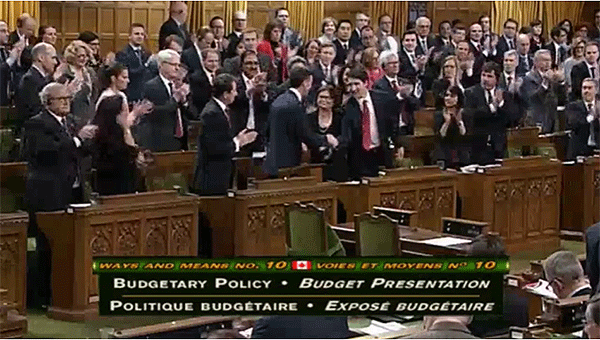
Budget 2017: Ho hum, nothing to see here
by Michael Ouellette, Editor, Canadian manufacturing.com

The second budget in the Trudeau mandate offered few policy changes but gives lots of room to maneuver. Here's a look at what's in it for business

Finance minister Bill Morneau is congratulated by Prime Minister Turdeau after finsihing his Budget 2017 speech. PHOTO: Screen capture of the federal government”s live stream.
In the minutes before Finance Minister Bill Morneau was set to stand and announce the budget, Rona Ambrose’s Conservative Party of Canada launched an honest-to-goodness filibuster. The move delayed the budget announcement by 30 minutes and added a much-needed sense of drama and a wee bit of irony to the afternoon.
The drama was needed because the actual budget offered none. The irony comes in the sense that the budget, bereft of the builder-style initiatives provided in last year’s policy document, was essentially a filibuster in paper form.
Gone are the “sunny ways” and sweeping optimism of the year prior. What we got was a pause. A delay—and a “let’s wait and see how this plays out.”
And just maybe, that’s exactly what Canada needed right now.
“Unfortunately, this is the position we are in,” said Jim Menzies, Canadian Manufacturing Industry Leader and Partner at tax services and advisory firm Grant Thornton LLP.
“Certainly, this is the most significant impact the U.S. has had on Canada’s policy in some time,” he added.
With a very large cloud of uncertainty hovering just south of our border, Prime Minister Justin Trudeau and his cabinet likely decided now was not the best time to lay all their cards on the table. It’s better to sit quietly, with a steely gaze and steady demeanor, and wait for the Americans to get their House in order.
Important negotiations are coming—NAFTA, immigration, security, dairy, softwood lumber, border taxes and Buy American provisions—everything will be on the table, and none of it is going to be easy.
“The impact of the U.S. on Canadian manufacturers is obvious, and this is the first time I’ve seen Canada act so cautiously on policy,” said Menzies.
From a business perspective, there are no immediate boosts in Budget 2017, but there’s nothing that stings either.
Tax rates weren’t tinkered with, the capital gains tax was left as-is and there were no changes to the accelerated capital cost allowance for writing off a portion of investments in new technology.
“In relation to tax rates, [the government] is purposefully holding back on that right now. Canada currently has a tax advantage over the U.S. and the government doesn’t want to tinker with that. Come the fall, there will be a lot more we understand about the actions of the U.S.,” said Menzies.
Infrastructure
The infrastructure bank was mentioned, but not with anywhere near the kind of pomp that came with it’s initial introduction and $35-billion promise.
Menzies doesn’t think the infrastructure bank is going to be up-and-running before the end of the year.
“Given that, it’s going to be a couple of years before the infrastructure bank will have any meaningful impact,” he says.
Deficit
The deficit is going up, and not everyone seems to care.
“Most were not expecting the deficit to be reduced in the near term,” said Menzies. “This budget was never going to focus on deficit, and its impact in the near term won’t be significant.”
Forecast to now hit $28.5 billion for this fiscal year, Finance Minister Morneau still believes the key is growth, and he’s not inclined to jeopardize the growth rate to get closer to balance.
Superclusters
While Budget 2017 is in most aspects a pause document, it includes some forward-looking initiatives to advance the economy and one of those is the Innovation Canada platform. Managed by Innovation, Science and Economic Development Canada (we used to call this Industry Canada), the goal is to place Canada firmly in the centre of the pending innovation economy.
The plan identifies six sectors that will be the engines of job creation in the coming decades and earmarks $950 million over five years to accelerate growth in these areas, but none of it is new money. $800 million will be drawn from the Budget 2016 provision for innovation networks and clusters, and $150 million will be drawn from the public transit and green infrastructure allocations provisioned in the 2016 Fall economic statement.
The superclusters that make up the focus of the program are: Advanced Manufacturing; Agri-food; Clean Technology; Digital Technology; Health, Bio-sciences and Clean Resources and Infrastructure and Transportation.
There aren’t a lot of details on how these will work, but the budget outlines a few ideas. This is pulled straight from Budget 2017:
• Risk sharing to develop platform technologies and disruptive technologies that will boost Canada’s competitiveness in areas of economic strength
• Strong connections between businesses, from large anchor firms to start-ups, post-secondary institutions and research institutions that support private sector-led research and development that is linked to commercial outcomes with application in the real economy.
• Create opportunities to grow Canadian companies through globally integrated supply chains.
• Diverse and skilled talent pools enhanced by advisory services and business mentoring for start-ups and small and medium-sized enterprises that lead to opportunities for Canadians to access high-value, well-paying jobs.
• Focus on innovative solutions that will improve the quality of life of Canadians and allow businesses to better perform in a competitive environment.
Strategic Innovation Fund
This $1.26 billion, five-year funding initiative combines four previous funds: the Strategic Aerospace and Defence Initiative, Technology Demonstration Program, Automotive Innovation Fund and Automotive Supplier Innovation Program.
The budget sets aside a further $200 million over three years, starting in 2017–18, on top of existing money. However, $100 million will be new funding and $100 million will be pulled from the $1 billion announced in Budget 2016 that was meant to support clean technology.
Check back for expanded coverage and click here to take a look at our entire coverage of Budget 2017.